It's been seven years since a University of Hawaii telescope spotted a strange object crossing our solar system. One-quarter mile (400 meters) long and maybe ten times as long as it is wide, thus unlike anything else we usually get to see around here, the object began fueling human imagination, with many of our kind hoping this was indeed the alien spacecraft they've been waiting for so long.
It wasn't, and our kind was capable of finally determining it was just another piece of space rock. Ok, maybe not just another piece of space rock, as this thing, baptized Oumuamua, is now officially "the first confirmed object from another star to visit our solar system." That's right, it's not from around here, but instead comes from a place outside Sol, a location we'll probably never be capable of determining.
Imagine just how exciting it would be for us to be capable of sending a spacecraft to the interstellar space object and snatching a sample of it for us to have a closer look at. What secrets could it hide? What wonders?
We are very capable of sending spacecraft to celestial objects to do that. We've performed this feat several times already, most recently with the OSIRIS-Rex spacecraft and the Bennu asteroid.
But that piece of rock was local, and we knew a lot about it already. Oumuamua is different. Unlike Bennu, it's not caught in an orbit, and at an average speed of 59,000 mph (95,000 kph), the window for a possible encounter with it is very short.
As it stands, none of the current means of space propulsion are capable of allowing a spacecraft to reach the speeds it would need to approach such a passing interstellar object and catch up with it.
And neither do some of the ones currently being researched. Solar sails, for instance, have the ability to send spacecraft very deep into space on long-duration missions, but they lack the ability to allow the hardware to make propulsive maneuvers in space.
Spaceships powered by nuclear could be the solution, but they are for now very expensive to make, and may turn out to be too large for their own good.
Over the years, NASA's Innovative Advanced Concepts (NIAC) program uncovered several means of alternative propulsion that may fit the requirements for a rendezvous with an interstellar space object. In 2021, for instance, someone proposed a radioisotope-electric-propulsion spacecraft.
This year another proposal was accepted in Phase 1 of the NIAC program. Born from the mind of James Bickford from the Charles Stark Draper Laboratory, it basically calls on using the momentum generated by the natural decay of a radioactive isotope to generate thrust.
The scientist imagines something described as a thin film nuclear isotope engine- the Thin Film Isotope Nuclear Engine Rocket (TFINER). We're basically talking about thin sheets of radioactive isotope. How thin? Well, think about 10-micron thick, which is about the typical length of a bacterium.
What kind of radioactive isotope? That would be Thorium-228. The stuff is known to have a half-life of 1.9 years, but more importantly, its decay chain generates extra alpha emissions, which on their own have a lifetime of anywhere between 300 nanoseconds and three days.
The isotope engine would generate thrust "when one side of the thin film is coated with a ~50-micron thick absorber that captures forward emissions." Bickford says "multiple stages consisting of longer half-life isotopes can be combined to maximize the velocity over extended mission timelines."
All of the above means, at least on paper, that the delta-V and lifetime of the spacecraft would be increased, without reducing thrust. The configuration would also allow active thrust vectoring and spacecraft maneuvers.
As per the one behind this idea, 30 kilos (66 pounds) of radioisotope could be spread over an area of 250 square meters (2,690 square feet), which should allow a ship to reach a top speed of 150,000 mph (540,000 kph). That, of course, could be scaled down to serve whatever needs space explorers would have.
With the above in mind, it's easy to imagine such a spacecraft reaching deep space relatively fast and catching up with pretty much all sorts of natural space objects.
The scientist does not publicly provide any other numbers relating to a potential spaceship using this system, but NASA seems to have liked the idea enough to include it in this year's NIAC Phase 1.
Granted, that doesn't mean a tangible product would result from this research, but it does paint the picture of countless possibilities at our disposal to advance our knowledge of space.
Bickford sees the system being used not only to allow rendezvous with a passing interstellar object but also as a means of propulsion for multi-target observations at the solar gravitational focus.
We'll keep an eye on this piece of technology just like we do with all other ideas of the NIAC program and update if anything worth mentioning happens.
Imagine just how exciting it would be for us to be capable of sending a spacecraft to the interstellar space object and snatching a sample of it for us to have a closer look at. What secrets could it hide? What wonders?
We are very capable of sending spacecraft to celestial objects to do that. We've performed this feat several times already, most recently with the OSIRIS-Rex spacecraft and the Bennu asteroid.
But that piece of rock was local, and we knew a lot about it already. Oumuamua is different. Unlike Bennu, it's not caught in an orbit, and at an average speed of 59,000 mph (95,000 kph), the window for a possible encounter with it is very short.
As it stands, none of the current means of space propulsion are capable of allowing a spacecraft to reach the speeds it would need to approach such a passing interstellar object and catch up with it.
And neither do some of the ones currently being researched. Solar sails, for instance, have the ability to send spacecraft very deep into space on long-duration missions, but they lack the ability to allow the hardware to make propulsive maneuvers in space.
Spaceships powered by nuclear could be the solution, but they are for now very expensive to make, and may turn out to be too large for their own good.
This year another proposal was accepted in Phase 1 of the NIAC program. Born from the mind of James Bickford from the Charles Stark Draper Laboratory, it basically calls on using the momentum generated by the natural decay of a radioactive isotope to generate thrust.
The scientist imagines something described as a thin film nuclear isotope engine- the Thin Film Isotope Nuclear Engine Rocket (TFINER). We're basically talking about thin sheets of radioactive isotope. How thin? Well, think about 10-micron thick, which is about the typical length of a bacterium.
What kind of radioactive isotope? That would be Thorium-228. The stuff is known to have a half-life of 1.9 years, but more importantly, its decay chain generates extra alpha emissions, which on their own have a lifetime of anywhere between 300 nanoseconds and three days.
The isotope engine would generate thrust "when one side of the thin film is coated with a ~50-micron thick absorber that captures forward emissions." Bickford says "multiple stages consisting of longer half-life isotopes can be combined to maximize the velocity over extended mission timelines."
All of the above means, at least on paper, that the delta-V and lifetime of the spacecraft would be increased, without reducing thrust. The configuration would also allow active thrust vectoring and spacecraft maneuvers.
With the above in mind, it's easy to imagine such a spacecraft reaching deep space relatively fast and catching up with pretty much all sorts of natural space objects.
The scientist does not publicly provide any other numbers relating to a potential spaceship using this system, but NASA seems to have liked the idea enough to include it in this year's NIAC Phase 1.
Granted, that doesn't mean a tangible product would result from this research, but it does paint the picture of countless possibilities at our disposal to advance our knowledge of space.
Bickford sees the system being used not only to allow rendezvous with a passing interstellar object but also as a means of propulsion for multi-target observations at the solar gravitational focus.
We'll keep an eye on this piece of technology just like we do with all other ideas of the NIAC program and update if anything worth mentioning happens.








